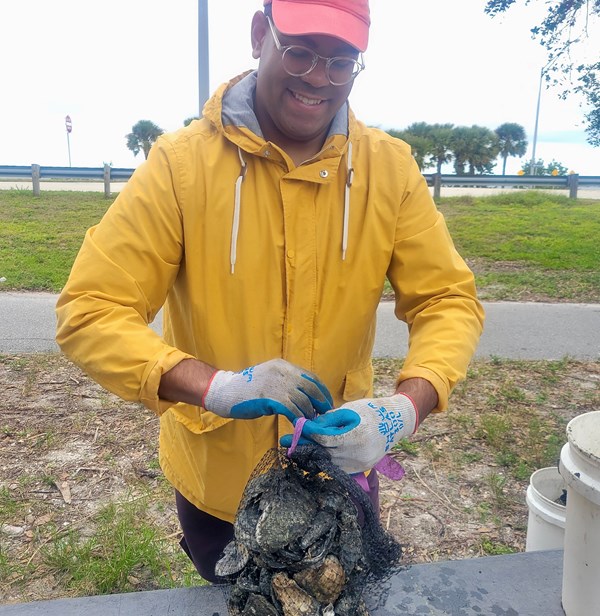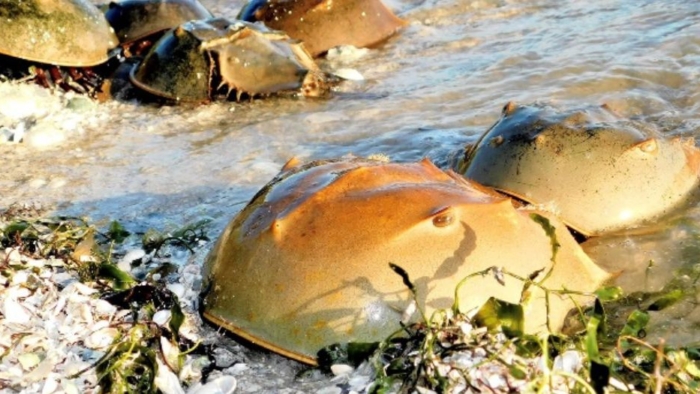
By: Michaela Stenerson
Titusville is a town on the east coast of Florida. At its eastern-most point you will not be looking out onto the Atlantic Ocean, you will be looking onto the Indian River Lagoon (IRL), a 156-mile long estuary which is a key biological highway for migratory birds and a hub of biodiversity.
Everyone who has grown up in this area seems to have a special connection with it. Kayaking, fishing, boating, and windsurfing are common recreational activities. I spoke with a local resident named Heather who has lived on this lagoon for over 40 years. She reflected that in the 1980s the water was clean and everyone ate of its abundance. She described what it was like living on the water:
“There were pulsating blobby creatures floating free, anemones with short, graceful tentacles, small sponges in oranges and browns, and various minnows and small crustaceans moving among them. There even were little mottled sea horses! Snails worked along the yellow-colored soft sand bottom. Skates rested in grass beds and foraged along the bottom, as did horseshoe crabs and blue crabs. A large, living oyster bed occupied the northeast corner of my waterfront.” She beamed, “I can’t believe I was that lucky, to move into that modest little house on South Banana River Drive and live amidst so much wild nature.”
In the last few decades this estuary has undergone substantial transformation. Today, those grassy beds are almost nonexistent. We went out with a local expert to observe one of the last bits of seagrass beds and although it was only a few feet deep, you could not see the grass unless you got your face right up to it. But what has caused all of this change?
Like any large problem, there are multiple factors that have combined to create the perfect storm. Leaking septic systems have leached high concentrations of nutrients into the groundwater which flows to the lagoon, and lawn fertilizers along with chemicals used outdoors on houses or cars have fed into the lagoon through storm water runoff. These high levels of nutrients overwhelm the water and lead to harmful algal blooms, which darken the water, cause oxygen levels to drop, and prevent sunlight from reaching the bottom. This prevents the growth of plants like seagrasses that are vital for the health of the ecosystem.

In 2021, manatees, which rely on seagrass as a primary part of their diet, experienced an Unprecedented Mortality Event (UME). Over 1,000 deaths were reported in one year, as opposed to the previous annual average of around 500. These deaths are believed to be linked to the disappearance of seagrass in places like the Indian River Lagoon. These beloved “ocean potatoes”—as locals lovingly call them— along with all the other creatures that inhabit these waters are only going to become less prevalent if things don’t turn around quickly. Unfortunately, since the lagoon has passed a sort of tipping point in nutrient load, it is going to take much longer to remedy its problems than it took to create them.
Similar to an orchestra of many different instruments that play together to make a symphony, an ecosystem functions best with many different players. High biodiversity is a good indicator of health in any ecosystem and as the lagoon’s waters remain polluted, its biodiversity will steadily decline.
Global climate change will likely exacerbate these struggles. In particular, it is predicted that changes in precipitation will cause long periods of dry spells followed by intense rainfall, which may increase pollutant loading and sea level rise. Increased hurricane activity will also likely cause more coastal flooding and eroding. These events would cause significant harm to the water quality of the lagoon.
What can be done to remedy all of this? Similar to the nature of the problem, the solution is multifaceted. The Indian River Lagoon Coalition (IRL Coalition) is a good place to start. This coalition comprises over 30 partner groups which are all working in their specialized ways towards a restored lagoon ecosystem. Some are amplifying the voice of the lagoon by sharing updates to the public about the status of the lagoon—like the Marine Resources Council which publishes an annual lagoon health report card. Others, like the Citizen’s Climate Lobby, are working to lobby government officials to take a stand for the lagoon. And others, such as the Brevard Zoo and its Restore Our Shores program, are working in the field monitoring oyster beds and clams to restore their populations—which have a great impact on water quality as these animals are filter feeders, sometimes filtering over 50 gallons of water a day. At the most recent meeting of the coalition, the focus was on the impact of septic systems on the health of the lagoon and steps were provided for locals to get their leaky tanks upgraded.

Our team in A Rocha Florida has been involved in numerous activities surrounding the lagoon. We have participated in mangrove gardening to assist in the growth of a species that provides key habitat for myriad invertebrates in the water. We have assisted the Brevard Zoo in clam and oyster monitoring, and we are beginning our venture into horseshoe crab tagging and monitoring as their spawning season begins. We are also beginning to study how far inland microplastics flow from the ocean through the lagoon.
The state of the lagoon, especially compared with its former glory, can seem depressing, but initiatives like the IRL Coalition are inspiring. We are praying and working for the restoration of these waters so that the whole community of creation may once again sing praise to him.









The saddest part of this is why are not these environmental groups starting at the simplified remedy first? Why with so much science based research can we not sway the municipalities of Florida to do more? Why do we continue to allow septic systems leach into the lagoon? Why do we still have non hurricane related vessels sinking in our lagoon…spewing gas, diesel and waste among our most precious lagoon? Are these not one on the most simplest, easy, immediate fixes to help to heal our lagoon? But yet out of all these so called environmental groups no one can achieve this task….why?
I live on the Indian River and have watched the decline. It does not matter where you live you have a stake in this. Estuaries are the nurseries of the ocean. I volunteer with Brevard Zoo’s oyster gardening, seagrass restoration. We can’t do it alone. We need everyone in this fight. Before the fish are gone. Before the manatees are gone. Before we pass the tipping point.
I graduated oceanography at FIT in 1980 and can attest to the good water quality by 1980. I was on the Indian river almost every day since I had a 13′ whaler. I’m retired now and considering moving back to the area. Let me know of any opportunities. Thank you.
George – thank you for sharing! I will pass this on to our FL team.
We built a couple solar powered prototype boats off Key West and sailed them over the last year up the Keys and intracoastal as far as Palm Coast. This year we are launching our first production boat Calypso that will cruise the north end of the lagoon and collect data while taking guests on slow zero-impact tours.
The advent of smart boats changes how we gather the data we need to tackle these challenges. I’m looking forward to working with folks like you to see how we can put that data to use.
It’s very sad watching the significant decline occurring in the IRL. We have such a beautiful, fragile ecosystem and it angers me to see how insignificant it is to city/county officials by continuing to allow condos and subdivisions being built right on the river. I am speaking of the one off 405 going out to KSC. This subdivision is going to be huge. It will have houses, condos, boat slips, a clubhouse and is currently under way with development. I think about what an impact it will make from all the new watercraft, displacement of all of the species of birds, and of course the highly fertilized lawns they will have. I moved here when I was 15, the water was clear, smelled of salt, and had an abundance of wildlife. I went to see someone on their boat at Titusville Marina, the water was murky and smelled like sewage. We are destroying this beautiful place. We must do something to get city/county to help stop further pollution. We need to save this important beautiful place!
For 5 years I gave an educational presentation to children about the marine life around Florida and the dangers of human trash to them. I had to stop due to the pandemic. I developed one on the IRL and the algal blooms and am working on one about the importance of mangroves to the marine life in the IRL. What is so maddening is the influx of people who don’t care and cut down the mangroves for the view and their indifference to the damage they are doing with their fertilizer run off not to mention the nutrients their dog poop adds to the Lagoon. I don’t understand why the state doesn’t make it mandatory that people on the water hook up to sewer and get rid of the septic tanks and I’m tired of money being the only thing that drives them allowing building on the water.